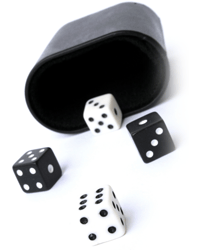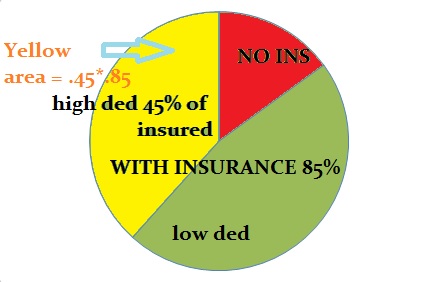How Do You Know When to Add or Multiply Probabilities
Probability of Two Events Occurring Together: Overview

Answering probability questions can seem tricky, but they all really boil down to two things:
- Figuring out if you multiply or add probabilities.
- Figuring out if you take dependent events (i event has an influence on the other) or independent (they have no consequence on each other)
Watch the video for an overview and examples:
Can't see the video? Click here.
Should I multiply or add probabilities?
Y'all would add probabilities if you lot want to find out if one outcome or some other could happen. For example, if you coil a die, and yous wanted to know the probability of rolling a one or a 6, then you would add the probabilities:
- Probability of rolling a i: ane/six
- Probability of rolling a vi: i/6
And so the probability of rolling a 1 or a vi is 1/half-dozen + one/vi = ii/6 = 1/3.
The probability of both events happening together on the same die is aught, at least with a single throw. But if you wanted to know the probability of rolling a 1 and and then rolling a 6, that's when you would multiply (the probability would exist ane/6 * 1/6 = 1/36).
Learning when to add or multiply can become actually confusing! The all-time fashion to learn when to add and when to multiply is to work out as many probability problems as you can. Simply, in general:
- If you lot take "or" in the wording, add the probabilities.
- If you take "and" in the wording, multiply the probabilities.
This is just a general rule: there will be exceptions!
Dependent vs. Independent
Dependent events are connected to each other. For example:
- In order to win at Monopoly, you have to play the game
- In order to notice a parking space, y'all have to drive
- Choosing two cards from a standard deck without replacement (the showtime choice has a 1/52 adventure, the second a 1/51).
Independent events aren't connected; the probability of one happening has no effect on the other. For example:
- Playing Monopoly isn't connected to winning at Scrabble.
- Winning the lottery isn't connected to yous winning at Monopoly.
- Choosing a carte and then rolling a die are not continued.
If yous aren't sure virtually the difference between contained and dependent events, you lot may want to read this commodity beginning:
Dependent or Independent consequence? how to Tell.
Tip: Look for key phrases in the question that tell you if an consequence is dependent or not. For example, when you are trying to figure out the probability of two events occurring together and the phrase "Out of this grouping" or "Of this group—" is included, that tells you the events are probably dependent.
Probability of Two Events Occurring Together: Contained
Use the specific multiplication dominion formula. Merely multiply the probability of the commencement event by the second. For case, if the probability of upshot A is ii/9 and the probability of result B is 3/9 then the probability of both events happening at the same time is (2/9)*(3/nine) = 6/81 = 2/27.
Instance problem: The probability of getting a task you applied for is 45% and the probability of you getting the flat you applied for is 75%. What is the probability of getting both the new job and the new machine?
Step one: Convert your percentages of the 2 events to decimals. In the above instance:
- 45% = .45.
- 75% = .75.
Step 2: Multiply the decimals from step 1 together:
.45 10 .75 = .3375 or 33.75 pct.
The probability of you lot getting the job and the car is 33.75%
That's it!
Probability of Two Events Occurring Together: Dependent
The equation you use is slightly different.
P(A and B) = P(A) · P(B|A)
where P(B|A) simply ways "the probability of B, given that A has already happened".
Instance problem: Eighty five per centum of employees have health insurance. Out of those 85%, 45% had deductibles higher than $1,000. What percentage of people had deductibles higher than $1,000?"
Step ane: Convert your percentages of the ii events to decimals. In the higher up instance:
- 85% = .85.
- 45% = .45.
Step ii: Multiply the decimals from step i together:
.85 10 .45 = .3825 or 38.35 per centum.
The probability of someone having a deductible of over $1,000 is 38.35%
That's how to observe the probability of two events occurring together!
Tip: Sometimes it tin can help to make a sketch or drawing of the problem to visualize what yous are trying to exercise. The post-obit diagram shows the grouping of people (85% of the population) and the subgroup (45% of the population), making it more obvious that you should exist multiplying (because when you translate 45% of the 85% (accept insurance with high deductibles) to math, you get .45 * .85).

References
Beyer, West. H. CRC Standard Mathematical Tables, 31st ed. Boca Raton, FL: CRC Printing, pp. 536 and 571, 2002.
Agresti A. (1990) Categorical Data Analysis. John Wiley and Sons, New York.
Vogt, W.P. (2005). Dictionary of Statistics & Methodology: A Nontechnical Guide for the Social Sciences. SAGE.
Wheelan, C. (2014). Naked Statistics. W. Westward. Norton & Company
---------------------------------------------------------------------------
Need aid with a homework or test question? With Chegg Written report, yous can become pace-by-step solutions to your questions from an practiced in the field. Your kickoff thirty minutes with a Chegg tutor is free!
Comments? Demand to post a correction? Please post a comment on our Facebook page .
Source: https://www.statisticshowto.com/probability-and-statistics/probability-main-index/how-to-find-the-probability-of-two-events-occurring-together/#:~:text=The%20best%20way%20to%20learn,the%20wording%2C%20multiply%20the%20probabilities.
Post a Comment for "How Do You Know When to Add or Multiply Probabilities"